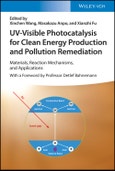UV-Visible Photocatalysis for Clean Energy Production and Pollution Remediation
Comprehensive resource detailing fundamentals of photocatalysis, clean energy production, and pollution treatment, as well as recent developments in each field
UV-Visible Photocatalysis for Clean Energy Production and Pollution Remediation: Materials, Reaction Mechanisms, and Applications provides current developments in photocatalytic reactions for both inorganic and organic-based materials which operate under UV-visible light or sunlight irradiation, with a focus on the fundamentals and applications in clean energy production and pollution remediation.
The text curates interesting and important research surrounding photocatalysis for hydrogen production, including the fundamentals and photocatalytic remediation of our better environments, which covers the reduction of CO2 and fixation of N2 with H2O under UV-visible light or sunlight irradiation. The first chapter of the book introduces these diverse subjects by including a brief history of the developments of photocatalysis research since around the 1960s.
Specific sample topics covered in this book include: - Visible-light active photocatalysts in pollutant degradation and conversion with simultaneous hydrogen production - Application of S-scheme heterojunction photocatalyst and the role of the defects on the photocatalytic reactions on ZnO - Strategies for promoting overall water splitting with particulate photocatalysts via single-step visible-light photoexcitation - Polymeric carbon nitride-based materials in aqueous suspensions for water photo-splitting and photo-reforming of biomass aqueous solutions to generate H2 - Visible light-responsive TiO2 thin film photocatalysts for the separate evolution of H2 and O2 from water
For chemists, scientists, physicists, and engineers across a wide range of disciplines, UV-Visible Photocatalysis for Clean Energy Production and Pollution Remediation is an essential resource for understanding current developments in photocatalytic reactions on both inorganic and organic-based materials which operate under UV-visible light or sunlight irradiation.
Comprehensive resource detailing fundamentals of photocatalysis, clean energy production, and pollution treatment, as well as recent developments in each field
UV-Visible Photocatalysis for Clean Energy Production and Pollution Remediation: Materials, Reaction Mechanisms, and Applications provides current developments in photocatalytic reactions for both inorganic and organic-based materials which operate under UV-visible light or sunlight irradiation, with a focus on the fundamentals and applications in clean energy production and pollution remediation.
The text curates interesting and important research surrounding photocatalysis for hydrogen production, including the fundamentals and photocatalytic remediation of our better environments, which covers the reduction of CO2 and fixation of N2 with H2O under UV-visible light or sunlight irradiation. The first chapter of the book introduces these diverse subjects by including a brief history of the developments of photocatalysis research since around the 1960s.
Specific sample topics covered in this book include: - Visible-light active photocatalysts in pollutant degradation and conversion with simultaneous hydrogen production - Application of S-scheme heterojunction photocatalyst and the role of the defects on the photocatalytic reactions on ZnO - Strategies for promoting overall water splitting with particulate photocatalysts via single-step visible-light photoexcitation - Polymeric carbon nitride-based materials in aqueous suspensions for water photo-splitting and photo-reforming of biomass aqueous solutions to generate H2 - Visible light-responsive TiO2 thin film photocatalysts for the separate evolution of H2 and O2 from water
For chemists, scientists, physicists, and engineers across a wide range of disciplines, UV-Visible Photocatalysis for Clean Energy Production and Pollution Remediation is an essential resource for understanding current developments in photocatalytic reactions on both inorganic and organic-based materials which operate under UV-visible light or sunlight irradiation.
Table of Contents
1. Introduction to integrate the diverse subjects and a brief historyPart I: Fundamentals of Visible Light-driven photocatalysis and Photocatalytic Splitting of Water to Produce H2:
2. Photocatalytic reaction mechanism
3. Photoctatalytic activity of TiO2 materials with iron and other metal species as phase-composition controllers
4. Modification of photocatalyst to achieve high performance
5. Conjugated polymer photocatalytic material
6. Highly efficient photocatalytic H2 production from H2O
7. Semiconducting photocatalytic materials to produce H2 from H2O under visible light irradiation
8. High efficient photocatalytic H2 production from H2O
9. Photocatalytic H2 evolution from H2O over g-C3N4
10. Efficient photocatalytic H2 production from H2O
11. Photocatalytic H2 production from H2O
12. Theoretical studies of photocatalytic H2 production from H2O
13. Photo-induced super-hydrophilicity on TiO2 surfaces; reaction mechanism and applications
Part II: Photocatalytic Reduction of CO2 with H2O and Fixation of N2:
14. Photocatalytic reduction of CO2 with H2O
15. Photocatalytic reduction of CO2 with H2O
16. Mechanistic study of photocatalytic CO2 reduction
17. Photocatalytic reduction of CO2 with H2O
18. Photocatalytic reduction of CO2 with H2O
19. Photocatalytic reduction of CO2 with H2O
20. Photocatalytic reduction of CO2 with H2O
21. Photocatalytic reduction of CO2 on reduced graphene oxide/TiO2
22. Photocatalytic activity of Pt/g-C3N4 nanosheets for solar fuel production
23. Photocatalytic fixation of N2
24. Photocatalytic fixation of N2
25. Photocatalytic fixation of N2
Part III. Photocatalytic Remediation and Selective Formation of Useful Molecules:
III-1 Photocatalytic degradation of organic pollutants in water
26. Photocatalytic degradation of polluted compounds
27. Photocatalytic degradation over TiO2-based photocatalysts
28. Photocatalytic degradation of aromatic compounds
29. Photocatalytic degradation of polluted compounds
30. Photocatalytic degradation
31 Photocatalytic degradation of polluted compounds
32. Photocatalytic purification of polluted water
33. Photocatalytic degradation of polluted compounds
III-2. Photocatalytic degradation to produce useful molecules from alcohols and biomass wastes
34. Selective oxidation of alcohols using carbon nitride photocatalysts
35. Photocatalytic selective reaction
III-3. Photocatalytic degradation in polluted compounds in air
36. Photocatalytic air purifying
III-4. Photocatalytic degradation reaction and the role of surface active sites
37. Photocatalytic reaction on ZnO and the role of the defects
38. Quantum dot-photocatalyzed reactions








